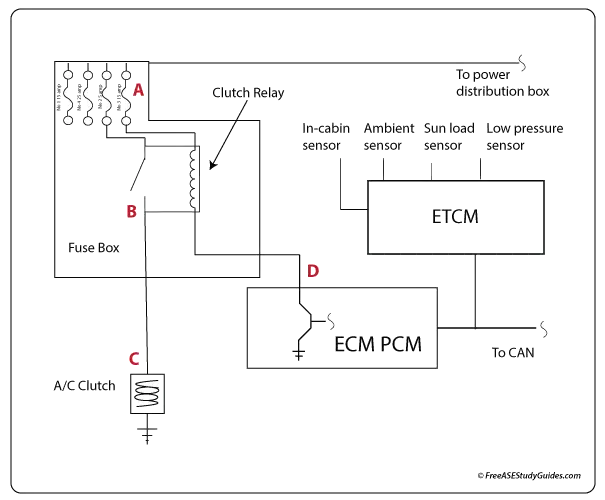ASE A7 Heating Air Conditioning Quiz
1. A vehicle with an EATC air conditioning system has low fan speed operation during high demand situations, like in direct sunlight. Technician A says this is because something is covering the sun load sensor's photo diode. Technician B says a sun load sensor is a variable resistor and can be tested with an ohmmeter. Who is correct?
2. A gurgling sound is heard coming from inside the dashboard of a vehicle. Technician A says this is air trapped in the heater core. Technician B says this noise can be caused by a blown head gasket. Who is correct?
3. A manifold gauge indicates a system has low discharge pressure. The MOST likely cause of this condition is:

4. There is a short to ground at point D of the electrical diagram above. Which of the following statements is true?
5. The compressor is rapidly cycling on and off on a CCOT air conditioning system. Technician A says this condition can be caused by a low refrigerant charge. Technician B says this could be caused by a faulty clutch cycling switch. Who is correct?
6. Technician A says while performing a retrofit from R-12 refrigerant to R134a refrigerant, the refrigerant must be recovered into a dedicated cylinder, they cannot be mixed. Technician B says R-12 refrigerant functions at higher pressures than R-134a refrigerant does. Who is correct?
7. Technician A says an ambient temperature sensor senses cabin air temperature. Technician B says a faulty ambient temperature sensor can prevent compressor clutch engagement. Who is correct?
8. During an initial inspection, the technician notices that one line on the receiver drier is cooler than the other. This is caused by:
10. Two technicians are discussing refrigerant storage. Technician A says HFC-134a is contained in a sky blue container. Technician B says CFC-12 is contained in a white container. Who is correct?
11. During a performance test on a CCOT system the manifold gauge indicates that the high side pressure is low and the low side pressure is high. This is caused by a:
12. An air conditioning system blows only warm air when the heater is on high output. Technician A says this could be a faulty heater control valve. Technician B says this could be caused by the cooling system's thermostat. Who is correct?
13. Technician A says a fixed orifice tube varies the flow of refrigerant in relation to temperature. Technician B says a fixed orifice tube is located between the condenser and the evaporator. Who is correct?
14. Technician A says the expansion valve is located on the inlet port of the evaporator. Technician B says the expansion valve's temperature sensing bulb is located near the outlet port of the evaporator. Who is correct?
15. Technician A says evacuating an air conditioning system will remove air, debris, and moisture. Technician B says to evacuate the system any time it's been exposed to the atmosphere. Who is correct?
16. During a visual inspection an oily spot is found on a hose leading from the compressor. Technician A says there may be a refrigerant leak in the system. Technician B says today's R134a systems use mineral oil instead of the older R12 compatible PAG oil. Who is correct?
17. An air conditioning system contains a thermostatic expansion valve. The suction line leading to the compressor is cool to the touch. This indicates:
19. A vehicle has poor air conditioning performance. The customer has added R134a refrigerant to the system. Technician A says to use a refrigerant identifier. Technician B says refrigerant mixtures are not recommended, but will not affect system pressures. Who is correct?
20. An air conditioner with an expansion valve performs poorly only during the hottest times of the day. Technician A says the receiver drier may be saturated. Technician B says there may be moisture in the refrigerant. Who is correct?
Please select an answer

